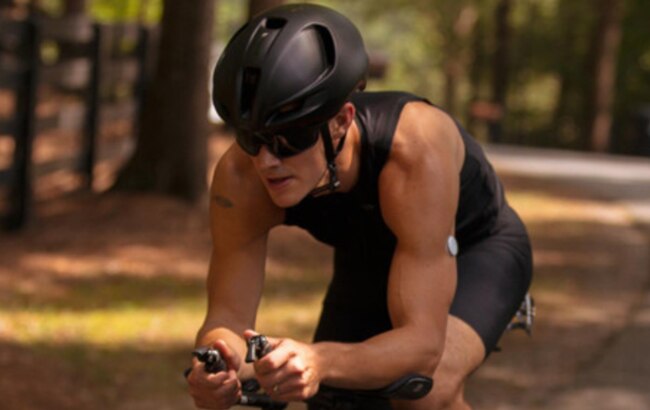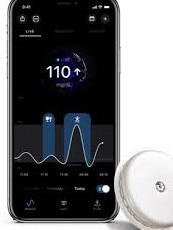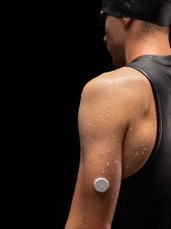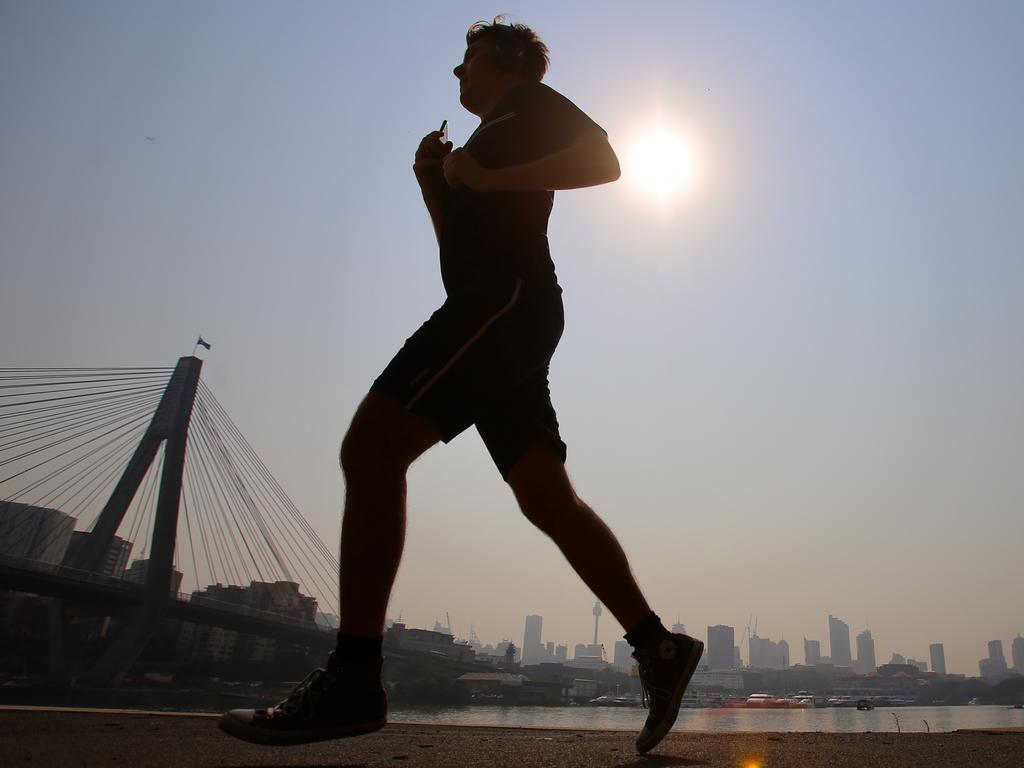Are blood sugar monitors the future of fitness?
Forget sleep and heart rate: a new gadget tracks glucose levels in your blood, and every sugary slip-up.

If I’m hesitating as I attempt to apply the latest data-tracking fitness accessory it is because it involves puncturing the skin of my upper arm to get started. In one hand I am holding an applicator the size of an egg cup, in the other a case containing a tiny biosensor and needle, the idea being that I connect and position them, then punch the “ultra-thin filament” just under my skin.
It sounds straightforward, but I can’t convince myself to perform the injection and in the end my husband does it for me. A short, sharp stab and the sensor is in situ, ready to provide readings that I’m told will reveal everything I need to know about my energy levels and powers of recovery.
Workout monitoring does not get much more futuristic. The device now lodged partly beneath my skin is a continuous blood glucose monitor (or CGM), a medical aid originally developed to track the blood sugar of people with diabetes that is now being pitched as a performance enhancer not only for top athletes but for anyone trying to improve their fitness.

This particular model, the Abbott Libre Sense Glucose Sport Biosensor, connects via Bluetooth to an app called Supersapiens (available on iOS and Android) to provide real-time feedback about how my body responds to food and exercise. The app is free but the sensors cost from $AU200 to $AU247 (depending on whether you buy them as a one-off or as part of a subscription) for two, which should each last 14 days.
Every sugary slip-up I make will reveal itself almost instantly as a spike on a graph plotting my glucose patterns.
Keeping tabs on blood sugar is already a trend in elite sport. Phil Southerland, the founder of the Atlanta-based Supersapiens company, says that 12 football clubs in the English Premier League use the system, as do a growing list of professional rugby players and top triathletes. Cyclists from some of the top teams at the Tour de France wore them in training as part of a trial last year and some athletes tested the sensors in the elite London marathon event held over 19 laps of St James’s Park in London last northern summer.
There are also signs that it could become the next thing the rest of us will be tracking. Rumours (so far unsubstantiated by the company) are circulating that a blood sugar sensor is to be a function of the next version of Apple Watch, while the British start-up company MyLevels is offering an app and sensor that monitor blood sugar levels to improve general health.
There is plenty of evidence that chronically elevated blood sugar is unhealthy. People with it are more likely to be overweight and are at greater risk of developing type 2 diabetes and heart disease. Yet even among healthy people blood glucose levels rise and fall daily, causing huge swings in energy levels. If you find yourself flagging on a bike ride or you have a mid-afternoon slump, you can probably blame your blood sugar.
Southerland says that there are 42 factors influencing the stability of blood glucose, ranging from diet, stress and sleep to altitude and temperature. “Even if you think you know what’s going to happen to your blood sugar, glucose has a habit of throwing you a curve ball,” he says.
Exercise and glucose
Exercise also has an impact, initially (and counterintuitively) causing blood sugar to shoot up, despite physical activity being the most effective way to regulate healthy blood sugar in the long term. “A short-term rise in blood sugar is most often seen in high-intensity exercise as stress hormone levels are higher and this stimulates the liver to break down glycogen and release it into the blood as glucose,” says Dr Sam Shepherd, a senior lecturer in sports and exercise nutrition at Liverpool John Moores University. “It’s completely normal and doesn’t last long since the glucose will subsequently be taken up into muscle and used as fuel for the exercise you are doing.”

All of this makes it easy to understand how tracking the ebb and flow of their blood sugar might help athletes to plan their diets with greater precision, learning when to eat and refuel so that they avoid energy slumps that might limit performance. Jenny Nesbitt, 26, a marathon runner from Worcester who is aiming to compete for Wales in the 2022 Commonwealth Games, is a case in point. She has been using the device for several months and says she has found that the results replay exactly how she feels at certain points in training. It has resulted in her tweaking her diet. “I’ve found that I can make small changes that will ultimately have a large impact on my performance and recovery. Instead of eating high-glucose foods such as honey, which makes my glucose levels become more unstable, before running, I’m using foods such as peanut butter, which stabilise my glucose levels and are much more beneficial.”
I find it almost impossible to resist eating something sugary to see what happens. The National Institute for Health and Care Excellence says that for people without diabetes normal blood glucose levels should measure 4.0-5.4 mmol/L (72-99 mg/DL) before a meal – mine are mostly trending at 72 mg/DL, the app tells me – and be less than 7.8 mmol/L (140 mg/DL) two hours after eating.
Sure enough, when I eat a flapjack, the graph on the app takes a sharp upward shift to 135-140 mg/DL after 15 minutes. After a hard seven-mile run it dipped to below 60 mg/DL. The idea is to stay within a target zone of 70-120 mg/DL and to minimise huge swings or limit your “glucose variability”. I soon become a slave to my blood sugar slumps and spikes.
While it is interesting, some of the information on the app is just too detailed to decipher, and for those of us not pursuing lofty performance goals, are they just more exercise statistics to think about when we are already drowning in data? One of Supersapiens’s advisers is Dave Brailsford, a former director of Team GB cycling and the coach who popularised the concept of marginal gains in sport. These are the small, seemingly insignificant steps that each produce an improvement amounting to maybe only a fraction of a second. Fine if you are planning on making the Olympics, but less necessary if your aim is just to complete the Great North Run in your fastest time.
Do you really need it?
Which raises the question: Olympic hopefuls aside, who might want to track their blood sugar? If you are someone who rarely leaves the gym (when they are open) for a workout or runs distances of less than 10 to 15km, it is probably not necessary. Our bodies have limited supplies of glucose, stored in the muscles and liver as glycogen, and it is only in prolonged endurance activities that levels decline to a point where they might challenge your ability to carry on.
“It becomes an issue in events like triathlons and marathons,” says David Stensel, a professor of exercise metabolism at Loughborough University. “Although you can top up your glucose with carbohydrate drinks and gels, it might be that CGMs are useful in ruling out problems.”
It might also help with weight control. It doesn’t take long to work out which foods cause your blood sugar to spike then crash, which dietitians will tell you leads to unhealthy snack attacks. Plain porridge helped to keep my blood sugar relatively stable, but adding fruit was less effective and a teaspoon of honey and coconut sent it soaring to 136.

Piles of green vegetables and snacks of walnuts or almonds were predictably fine, but there were surprises — white potato mashed with milk produced less of a blood sugar increase than sweet potato. It is recommended that you use the biosensor for at least a month to track patterns and pinpoint pitfalls. I can see that weight would drop off if you are prone to lots of sugary highs and use it to eliminate them.
There are limitations, not least that if you don’t like needles you are on the back foot before you start. Shepherd says that CGMs use interstitial fluid from around the cells to measure glucose and this provides a less than “real-time” reading. “There is about a 15-minute lag time,” he says. “So if you consumed a sports drink your blood sugar would spike after 30 minutes, but you wouldn’t see this until after 45 minutes on the monitor.”
And although it should stay in place for 14 days, the sensor will need replacing if it falls off. “Doors are an enemy of the biosensor because people bump into them and knock them off,” Southerland says. “So are sports bras as they are so difficult to get on.”
My biosensor fell off four days in when I was sleeping. Will I replace it? Probably. Scientists are beginning to think that consistently high levels of blood sugar can undermine the beneficial effects of aerobic exercise, which is yet another reason to keep it in check. One recent study published in the journal Nature Metabolism put 24 young adults, none of whom had type 2 diabetes, through treadmill running tests and showed that those with the worst blood glucose control also had the lowest levels of endurance. It may well be that blood sugar monitoring soon becomes as commonplace as tracking your sleep and steps.
The Times







To join the conversation, please log in. Don't have an account? Register
Join the conversation, you are commenting as Logout